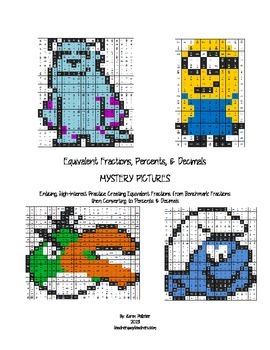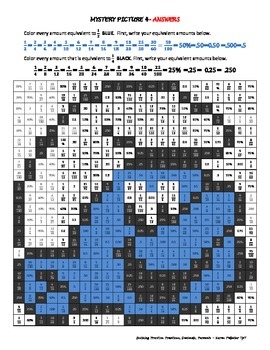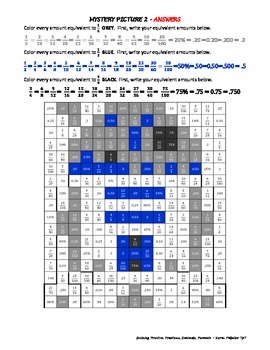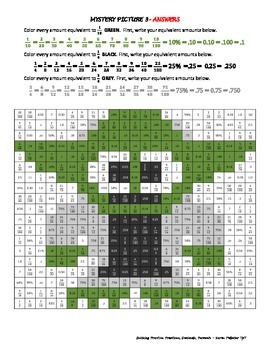Enticing Practice: Equivalent Fractions, Percents & Decimals Mystery Pictures
Karen Pelletier
548 Followers
Grade Levels
4th - 6th
Subjects
Resource Type
Standards
CCSS4.NF.A.1
CCSS5.NF.A.1
CCSS4.NF.C.5
CCSS4.NF.C.6
Formats Included
- PDF
Pages
25 pages
Karen Pelletier
548 Followers
What educators are saying
My students got really excited when I used these activities. They make great station activities. It is and easy way to encourage them to practice their skills when you've taught a particular skill.
Great resource I utilized during my intervention period with students who needed additional practice with these specific skills.
Description
Enticing, High-Interest Practice Creating Equivalent Fractions from Benchmark Fractions then Converting to Percents & Decimals
If you’re looking for an enticing way to get struggling students to practice converting fractions to percents and decimals and actually CARE about it, then these 6 Mystery Pictures are for you. Converting fractions is one of those skills that if not grasped, can keep you from moving forward in the curriculum. Stop spending time in class going over and over the same skill, and get the students to practice on their own with these Mystery Pictures!
Mystery Pictures are fun and relevant and include characters from favorite movies/video games like Despicable Me, Monsters University, Angry Birds and more! Students will want to spend time converting fractions to percents and decimals. Then students concentrate on recognizing them just to solve the Mystery Picture! I have found that most students don’t just recognize equivalent fractions without actually manually figuring out the conversion.
These Mystery Pictures are intentionally LONG activities requiring more time on task for your students, so that they recognize common equivalent fractions-decimals-percents without having to convert each time.
If students have been taught the basic idea of how to convert fractions to decimals and percents, students should be able to complete these activities independently, with help of the Student Support Sheet if needed. Higher students can skip the Student Support Sheet and go straight to the Mystery Picture… built in differentiation!
The great thing about these Mystery Sheets is that they actually allow students to check their own work! Students can see if they have made a mistake if their Mystery Picture is not looking familiar. Students will examine their paper to find a mistake if their picture is not just “so.”
These sheets are great for homework, for substitutes, for centers, or for keeping the rest of your class busy while you finally find some time to re-teach something else because they are time-consuming.
Finally, an activity that will keep ALL of your students busy for a long period. My 6th and 9th grade daughters each worked quietly for over 25 minutes completing one!
You get 6 Mystery Pictures concentrating on the most common, easily converted fractions: Use them 1x a week for 6 weeks, 2x a week for 3 weeks, or as you wish! My grade level does Mystery Mondays. This is a homework assignment my students ask for!
I have included an EXTRA SAMPLE Mystery Picture for you to do one WITH the students. Also, teach your students the most efficient searching strategy. Students who jump around will have a harder time. I, personally show suggest students convert 1 fraction at a time, then look for and color those all the same color. Then, move on to the next fraction, and color all of that color.
P.S. I found twistable colored pencils at Dollar General for $1.25. These keep students from having to get up and sharpen, or worry about breaking pencils at home.
If you’re looking for an enticing way to get struggling students to practice converting fractions to percents and decimals and actually CARE about it, then these 6 Mystery Pictures are for you. Converting fractions is one of those skills that if not grasped, can keep you from moving forward in the curriculum. Stop spending time in class going over and over the same skill, and get the students to practice on their own with these Mystery Pictures!
Mystery Pictures are fun and relevant and include characters from favorite movies/video games like Despicable Me, Monsters University, Angry Birds and more! Students will want to spend time converting fractions to percents and decimals. Then students concentrate on recognizing them just to solve the Mystery Picture! I have found that most students don’t just recognize equivalent fractions without actually manually figuring out the conversion.
These Mystery Pictures are intentionally LONG activities requiring more time on task for your students, so that they recognize common equivalent fractions-decimals-percents without having to convert each time.
If students have been taught the basic idea of how to convert fractions to decimals and percents, students should be able to complete these activities independently, with help of the Student Support Sheet if needed. Higher students can skip the Student Support Sheet and go straight to the Mystery Picture… built in differentiation!
The great thing about these Mystery Sheets is that they actually allow students to check their own work! Students can see if they have made a mistake if their Mystery Picture is not looking familiar. Students will examine their paper to find a mistake if their picture is not just “so.”
These sheets are great for homework, for substitutes, for centers, or for keeping the rest of your class busy while you finally find some time to re-teach something else because they are time-consuming.
Finally, an activity that will keep ALL of your students busy for a long period. My 6th and 9th grade daughters each worked quietly for over 25 minutes completing one!
You get 6 Mystery Pictures concentrating on the most common, easily converted fractions: Use them 1x a week for 6 weeks, 2x a week for 3 weeks, or as you wish! My grade level does Mystery Mondays. This is a homework assignment my students ask for!
I have included an EXTRA SAMPLE Mystery Picture for you to do one WITH the students. Also, teach your students the most efficient searching strategy. Students who jump around will have a harder time. I, personally show suggest students convert 1 fraction at a time, then look for and color those all the same color. Then, move on to the next fraction, and color all of that color.
P.S. I found twistable colored pencils at Dollar General for $1.25. These keep students from having to get up and sharpen, or worry about breaking pencils at home.
Total Pages
25 pages
Answer Key
Included
Teaching Duration
1 hour
Report this resource to TPT
Reported resources will be reviewed by our team. Report this resource to let us know if this resource violates TPT’s content guidelines.
Standards
to see state-specific standards (only available in the US).
CCSS4.NF.A.1
Explain why a fraction 𝘢/𝘣 is equivalent to a fraction (𝘯 × 𝘢)/(𝘯 × 𝘣) by using visual fraction models, with attention to how the number and size of the parts differ even though the two fractions themselves are the same size. Use this principle to recognize and generate equivalent fractions.
CCSS5.NF.A.1
Add and subtract fractions with unlike denominators (including mixed numbers) by replacing given fractions with equivalent fractions in such a way as to produce an equivalent sum or difference of fractions with like denominators. For example, 2/3 + 5/4 = 8/12 + 15/12 = 23/12. (In general, 𝘢/𝘣 + 𝘤/𝘥 = (𝘢𝘥 + 𝘣𝘤)/𝘣𝘥.)
CCSS4.NF.C.5
Express a fraction with denominator 10 as an equivalent fraction with denominator 100, and use this technique to add two fractions with respective denominators 10 and 100. For example, express 3/10 as 30/100, and add 3/10 + 4/100 = 34/100.
CCSS4.NF.C.6
Use decimal notation for fractions with denominators 10 or 100. For example, rewrite 0.62 as 62/100; describe a length as 0.62 meters; locate 0.62 on a number line diagram.





